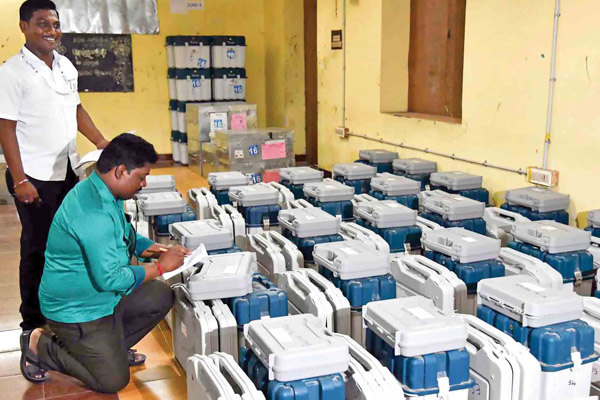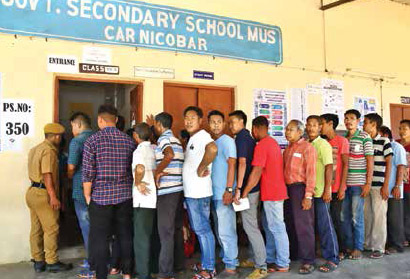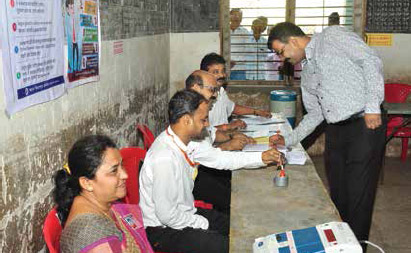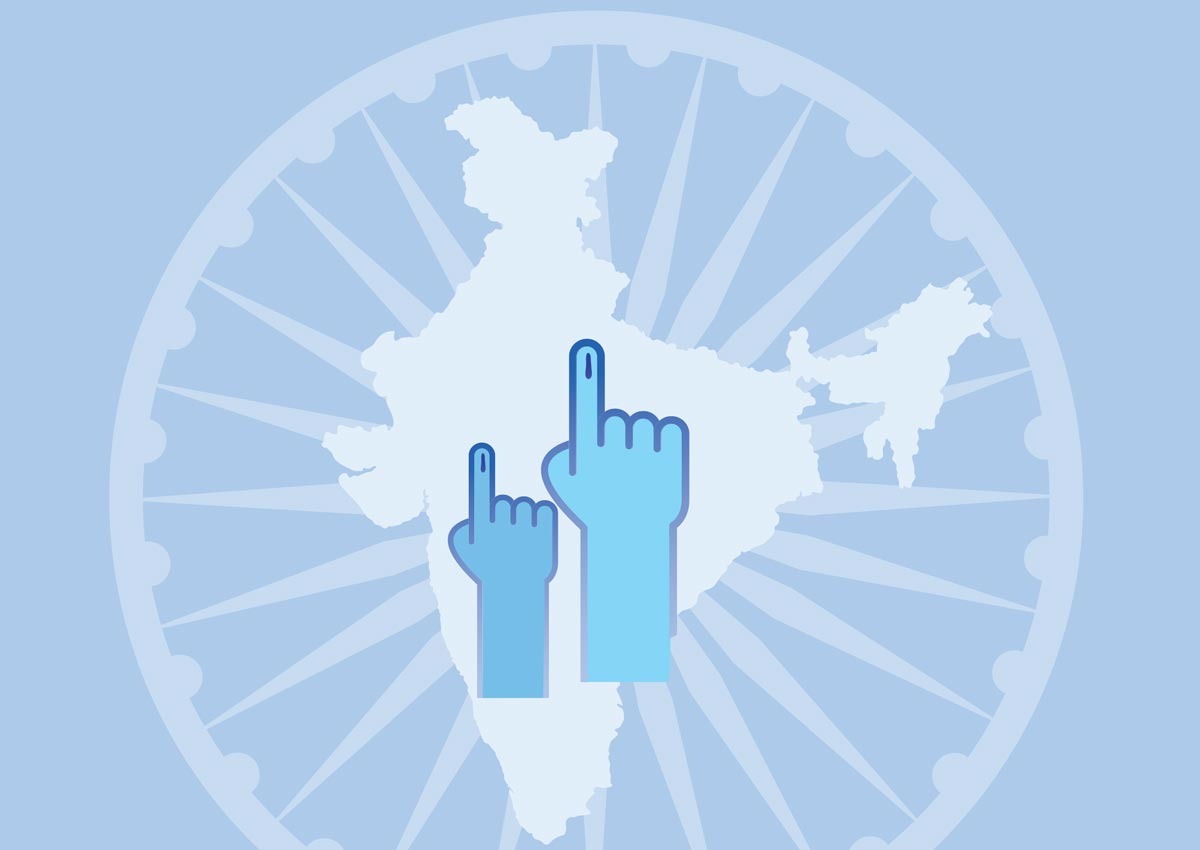From the material dug out from various media sources, certain ground truths have emerged as to how the Election 2019 was conducted and how people exercised their mandate. First and foremost, the polling itself was organised over 6 weeks, citing security reasons which are never explained. This helped the ruling party, which is also the richest party to easily carry on its campaign while the rest of the parties find their funds being spread thin.
The Election Commission of India (ECI) took four weeks to decide on electoral complaints against the Prime Minister and the ruling party president, and 4-5 days to decide on almost identical complaints against others. Other politicians were held guilty for the same offences for which the PM and ruling party president were given clean chit, not once but several times.
Large number of names of people from marginalised and minority groups who are unlikely to vote for the ruling party—particularly lower castes, Muslims and Christians—were found to be missing from the voters list. So were the names of millions of women. Number is estimated at 130 million, which is 14 per cent of the total voters, and would have made all the difference between victory and defeat.
There was widespread practice of electoral bribery—people being given money for not casting their vote, or for voting in favour of the ruling party. Goons were pressed into service to force people to press the button in favour of a particular party. The army of ECI observers and micro-observers did not make any difference.
About 2 million Electronic Voting Machines (EVMs) were stated to be missing from the ECI. ECI has no explanation for this. The records of the two public sector companies who manufacture EVMs say that they have been paid Rs 116 crore more than what the ECI says they have been paid according to declared contracts, raising the question of what work this extra payment was for, and who made it.
ECI says the EVMs can be programmed only once, making hacking unlikely. However, there are reports that it can be programmed several times. There are other reports saying that the EVM machine can be manipulated by connecting it to cell phones, blue-tooth devices, replacing parts of it, and other forms of manipulation, apart from physical replacement of it by other EVMs.
Large number of names of people from marginalised and minority groups who are unlikely to vote for the ruling party—particularly lower castes, Muslims and Christians—were found to be missing from the voters list. So were the names of millions of women. Number is estimated at 130 million, which is 14 per cent of the total voters, and would have made all the difference between victory and defeat
After the final vote was cast there were video reports from at least 10 different places of new EVMs being moved into strong rooms. ECI said these were reserve EVMs, but provided no evidence for this and no explanation for why they need to be moved just before counting rather than at the time of voting, which was, in some cases, weeks later. They also provided no explanation as to why, as required by the EC rules, there were no security officers accompanying these vehicles, and why these vehicles were often un-numbered, unofficial vehicles. Doubt arises as to whether these are part of the two million missing EVMs! There have also been reports of irregularities in the counting process.
Another media source says that it had deep-dived into two sets of data shared by the ECI; first, the voter turnout/votes polled data on the EVMs and second, the votes counted data, and had found serious discrepancies in the two sets of data in 373 constituencies which went to polls in the first four phases of the election. When this source raised the issue of discrepancies with the ECI the ticker mentioning “final voter turnout” mysteriously disappeared from the EC’s website (eciresults.nic.in.) When asked why the ticker and the data has been removed from the website, there was no response.
Machine-voting has no integrity
In India, polling is done with machines (EVM) which is a technology device. The integrity of EVMs has been challenged from the time they were introduced in 1999. It flared up in 2009 soon after UPA’s repeat victory in the parliamentary elections. The most articulated challenge to EVM’s integrity came from those aligned with the BJP. The most active ‘activist’ who had launched a virtual war against EVM was GVL Narasimha Rao, BJP spokesperson-turned-Rajya Sabha MP. Grounds on which he trashed EVMs were many: the whole world has discarded similar EVMs; use of EVM is unconstitutional and illegal; EVM software and hardware are not safe; EVMs are sitting ducks; insider fraud, storing and counting are concerns; ECI is clueless on technology and there is trust deficit.
Developing these grounds, he published a book titled ‘Democracy at Risk—Can we trust our EVM?’ (2010), for which BJP founder and its senior most leader—LK Advani—wrote an approving foreword! For effect he added: “I personally regard it significant that Germany, technologically, one of the most advanced countries of the world, has become so wary of EVMs as to ban their use altogether.” What is more, he strongly advocated Voter Verifiable Paper Audit Trail (VVPAT) to be introduced immediately. Maverick Subramanian Swamy jumped into the fray and challenged the EVM in the Delhi High Court and then took it to the Supreme Court and got the order to have VVPAT in every EVM vide its judgment dated October 8, 2013. This ipso facto meant that EVM should be used for voting and all the printed slips in the VVPAT machine should be counted before declaring results.But with BJP victory in 2014 election, EVM haters became EVM worshippers. Nevertheless, pursuant to the October 8, 2013, order of the Supreme Court and other directives, ECI arranged for all EVMs to be accompanied with VVPAT for the 2019 general elections. Main purpose was to bring in accuracy, verifiability and transparency in the casting and counting of votes. Without counting of VVPAT paper slips in a significant percentage of polling stations in each assembly constituency, the objectives of verifiability and transparency in the democratic process would remain unrealised.

About 2 million Electronic Voting Machines (EVMs) were stated to be missing from the ECI. ECI has no explanation for this. The records of the two public sector companies who manufacture EVMs say that they have been paid Rs 116 crore more than what the ECI says they have been paid according to declared contracts, raising the question of what work this extra payment was for, and who made it
But, in defiance of this basic principle vide its letter dated February 13, 2018, ECI directed state chief electoral officers to mandatorily verify VVPAT paper slips in only one randomly selected polling station in each assembly constituency. This defeated the very object of installing VVPATs in all EVMs which tantamount to non-implementation of Supreme Court Order.
ECI trashes Constitutional Conduct Group
Hence on April 10, 2018, Forum for Electoral Integrity (FEI), of which I am the convener, wrote a detailed letter to the ECI explaining the need for a much higher sample for verification so that EVM-voting adheres to basic ‘democratic principles’: (a) All essential steps in the elections should be subject to public examination; (b) Ordinary citizens should have knowledge to check the essential steps in the election process; and (c) There should be transparency in the counting of votes and ascertainment of the results reliably.
FEI, therefore, suggested that VVPAT slips must be simultaneously counted for a sample size of at least 25 per cent of the polling stations in an Assembly Constituency with the samples drawn randomly from the different strata and verified with the electronic count. If any variation was found then the entire VVPAT slips in the constituency should be counted and tallied with the electronic count before declaring the result. This would have brought about substantial degree of integrity in the 2019 Parliament election. But that was not to be!
ECI’s reply dated May 1, 2018, signed by Sudeep Jain, Deputy Election Commissioner (DEC) in charge of EVM, was typically bureaucratic and only gave technical, administrative, legal and physical security arguments in favour of EVMs. Not a whimper about democratic principles and electoral integrity emphasised upon in FEI’s letter. This matter, therefore, went before the Constitutional Conduct Group (CCG) of retired civil servants, many of whom have conducted, monitored and observed elections during their service. This Group held a well-attended conclave on the subject in Delhi on June 8, 2018, and thereafter submitted a Memorandum on the subject to the Chief Election Commissioner (CEC). On CEC’s advise a brainstorming session on the subject was held on July 21stat IIM, Bangalore.
ECI had taken the interaction seriously and was present in strength led by CEC OP Rawat. Others were Prof Sahni of IIT, Delhi, who is Chairman of EC Technical Expert Committee, Sudeep Jain, DEC, Karnataka CEO and CMD, BEL and a senior representative from ECIL, the last two being manufacturers of EVM and VVPAT.

Jain made a detailed presentation on EVM and VVPAT. This was followed by my intervention wherein I contended that the EVMs may be devices of technology excellence, but do they comply with principles of democracy. It was therefore suggested that VVPAT slips be simultaneously counted for a sample size of at least 25 per cent of the polling booths (VVPATs) in an Assembly Constituency with the samples drawn randomly from the different strata and verified with the electronic count. If any variation was found then the entire VVPAT slips should be counted and tallied with the electronic count before declaring the result.
Prof Sahni endorsed our suggestion. CEC Rawat was very positive and promised that ECI will work closely with CCG in the compliance of principles of democracy and electoral integrity. But this was not to be, because DEC Jain was reportedly already on the job of sabotaging the whole thing as part of a pre-set agenda and saw to it that nothing happened till CEC Rawat retired on December 1, 2018.
The integrity of EVMs has been challenged from the time they were introduced in 1999. It flared up in 2009 soon after UPA’s repeat victory in the parliamentary elections. The most articulated challenge to EVM’s integrity came from those aligned with the BJP. The most active ‘activist’ who had launched a virtual war against EVM was GVL Narasimha Rao, BJP spokesperson turned-Rajya Sabha MP
While so, an expert opinion on statistical sample size from Dr SK Nath, former Director General, Central Statistical Organisation (CSO), and an international consultant was sent to ECI. In the meantime, one of CCG members Ashok Vardhan Shetty published a paper on the subject in The Hindu. ECI formed an expert committee and nominated Ashok as a member and also invited Dr Nath. The first meeting of the committee was held on October 4, 2018, at the Indian Statistical Institute (ISI), New Delhi. Dr Abhay Bhatt of ISI and Dr RajivaKarandikar of Chennai Mathematical Institute (CMI), who attended the meeting, said that the sample size needed for India as a whole (10.35 lakh EVMs) was only 479 and that the sample size may be treated as constant as it doesn’t vary much with population size. Ashok Shetty dissented and Dr Nath also didn’t agree. But Jain ensured that ECI stuck to its one booth per Assembly constituency principle, completely oblivious of public confidence and integrity of elections.
ECI perjures in Supreme Court
From the beginning I knew nothing would come out of CCG interaction with ECI. So I, along with KP Fabian, another member of CCG, did research and filed a PIL in the Supreme Court duly supported by Dr Nath’s expert opinion taking Assembly constituency as population with a 98 per cent confidence level of tamper-free and a bias-free election. Taking average of 240 polling stations per assembly constituency (which is mostly the case) at least 92 polling stations have to be cross-verified by manual counting which works out to be well over 30 per cent.
SC admitted our writ petition in early January 2019 and issued a notice to ECI. Faced with irrefutable facts, ECI avoided filing a counter and when it did it was all humbug—the same parrot-like narration of the technological and administrative arrangements without even touching upon the democratic principles of examinability, knowledge of the voter and transparency in counting. It was at this stage that 21 political parties under the ‘leadership’ of Chandrababu Naidu entered the scene by filing a separate PIL seeking 50 per cent VVPAT slip count.

Complaint & the reply
Sir,
I am placing the following documents in your kind notice:
1. EVM Count Sheet in respect of Polling Station no 136, signed by the Asstt Returning Officer, Badnagar, Lok Sabha Constituency Ujjain (MP).
I. iBallot Account sheet of the Presiding officer, Polling Station no. 136.
II. Electoral Roll of the Polling Station no 136.
2. According to EVM Count Sheet, the number of votes counted by the EVM of Polling Station no 136 is: 841 (BJP: 630, Congress: 186, others: 25). According to the Ballot Account of the Presiding Officer, the no of voters in the polling station is 481 (477 voters registered in the Electoral Roll + 4 EDC (Election Duty Certificate Voters). I checked the number of voters in the Electoral Roll of the Polling Station no 136, which is available on the internet. According to the Electoral Roll, there are 477 registered voters, as the Presiding Officer has recorded in his Ballot Account.
3. The fact that EVM recorded 841 votes, when there are only 481 voters who could have cast their votes in this polling station, is prima facie evidence of serious fraud in the election.

4. The Election Commission announced the result, even in the face of this glaring mismatch, without placing in the public domain any clarification on this mismatch. The Election Commission did not place in the public domain whether there was a VVPAT count to match this EVM, and if so, with what result. Election Commission, on the other hand, made a public announcement that VVPAT counts have not revealed any mismatch.
5. As a citizen, I am interested in a free and fair poll, the very foundation of our democracy and the Constitution. I, therefore, most humbly request for a clarification on this serious mismatch.
Yours faithfully,
Surendra Nath
[IAS (Retd), former Secretary to Government of India]
Jain filed a common counter affidavit reportedly making blatantly false claims. Among other falsehoods, the affidavit claims that there had not been any mismatch in the VVPAT and EVM tallies conducted in the past two years, and that the ECI had only received one complaint about a VVPAT recording an incorrect vote since 2013. Jain also made the absurd claim that 50 per cent VVPAT verification would delay the counting process by up to five or six days whereas even under paper ballot system with 100 per cent counting almost all results including large parliament constituencies were declared within 10 to 16 hours of the start of counting.

But the ‘height of perjury’ goes to the false claim of a non-existent report of the ISI in favour of a miniscule sample size. Jain’s affidavit notes that a three-member committee, comprising Abhay G Bhatt of the ISI, RajeevaKarandikar of the CMI and Onkar Prasad Ghosh of CSO, authored the study. The so-called ISI Report, taking election in the entire country as a single event, claimed that tallying of 479 randomly selected booths was enough to verify the fairness of the elections above 99.99 confidence level. How absurd!
On verification it transpired this ‘Committee’ was set up by Jain—by writing a letter, not to the Director of ISI, Kolkata but to Prof Bhat, the head of its Delhi unit, asking for “associating with the commission and collaborating towards resolving the issues elaborated above…”. It did not ask ISI to form an expert committee; it only asked Professor Bhatt collaborate with the ECI in examining the issue. An RTI reply shows that this letter addressed to Prof Bhat was received but ISI has no further record of any action taken or the formation of a formal ‘ISI’ committee as per the Standard Operating Procedure. The composition of the body seems to be a private decision worked out by Jain and Prof Bhat, without any ISI process and the report, therefore, is a private one and not that of ISI.

To quote the noted election security expert Bruce Schenier: “Elections serve two purposes. The first, and obvious, purpose is to accurately choose the winner. But the second is equally important: to convince the loser. To the extent that an election system is not transparently and auditably accurate, it fails in that second purpose.” Tallying large number of VVPAT slips with electronic count is to convince people of the integrity and fairness of the elections. Even without any demand, ECI should have done this suo motto. Not doing so even after widespread public suspicion about EVM and 21 opposition parties as well as civil society asking for it is a clear case of compromised integrity.
Supreme Court renders Kangaroo justice
Supreme Court, it appears, had no time for mundane matters like democratic principles, public confidence and electoral integrity. This could be seen from a bare reading of the “Judgment” dated April 8, 2019. Herewith is the operative portion: “…our considered view is that having regard to the totality of the facts of the case and need to generate the greatest degree of satisfaction in all with regard to the full accuracy of the election results, the number of EVMs that would now be subjected to verification so far as VVPAT paper trail is concerned would be 5 per Assembly Constituency or Assembly Segments in a Parliamentary Constituency instead of what is provided by Guideline No. 16.6, namely, one machine per Assembly Constituency or Assembly Segment in a Parliamentary Constituency….”
Five VVPAT machines per Assembly constituency increased the sample size from microscopic 0.5 per cent to miniscule 2 per cent, whereas we had asked for reasonable 30 per cent and political parties 50 per cent! If this is not Kangaroo justice what else is? We and the political parties filed Review Petition in the SC with solid evidence of EVM-VVPAT fraud and malfunctioning in the first three phases of Election 2019 as well as perjury committed by DEC Jain regarding the ‘ISI Report’” The court summarily dismissed it on May 7, 2019, without even listening to the senior advocates who had lined up for argument!
Among other falsehoods, the (ECI) affidavit claims that there had not been any mismatch in the VVPAT and EVM tallies conducted in the past two years, and that the ECI had only received one complaint about a VVPAT recording an incorrect vote since 2013. (DEC Sudeep) Jain also made the absurd claim that 50 per cent VVPAT verification would delay the counting process by up to five or six days whereas even under paper ballot system with 100 per cent counting almost all results including large parliament constituencies were declared within 10 to 16 hours of the start of counting
In utter desperation, 21 political parties pleaded with ECI to at least manually count the measly 2 per cent VVPAT slips upfront and do the verification before the main electronic count. It would have served some purpose if this had been done at front-end as requested. But ECI rudely rejected this very genuine demand and pushed the ‘verification’ to the back-end well past midnight. In the event, not even one VVPAT slip was counted and matched before the entire electronic count was done, results announced and everything, including singing and dancing, was over. Mainstream media behaved as mercenaries heralding this farce without even once questioning the integrity or fairness of the electoral process. Now there are avalanche of reports about mismatch and excess counting in many booths and constituencies and ECI is unable to respond. And the mainstream media continues to be deaf, dumb and mute! Please see a shocking case of excess counting in Madhya Pradesh. [Box]
What is Electoral Integrity?
Election is the essence of democracy. Integrity is described as “uncompromising adherence to moral and ethical principles; soundness of moral character; honesty.” Electoral integrity has certain basic ingredients:
• Impeccable Electoral Roll without leaving out a single eligible voter.
• Level-playing field in terms of availability of funds and enforcement of Rules/Codes. Through deceitful and legally untenable means (Electoral Bonds) ruling party commandeered huge funds for itself while depriving the opposition.
• Ethical voting i.e. no buying and selling of votes or vote capturing.
• Polling and counting complying with essential ‘democracy principles.’
Election 2019 did not even have one. What is worse, technology has transformed people’s mandate into a machine-made verdict!
Tailpiece
In his seminal work ‘The Oak and the Calf’ Alexander Solzhenitsyn famously wrote: “It is infinitely difficult to begin when mere words must move a great block of inert matter. But there is no other way if none of the material strength is on your side. And a shout in the mountains has been known to cause an avalanche.” I have mere words and no material strength. And there is no hope of any avalanche. Yet, if this expose can facilitate a rapid return to the good-old ballot-paper system that fulfills all ‘democracy principles’ and is prevalent in all genuine democracies in the world that would be reward enough.
Writer is a former Army and IAS Officer


























































